A Beginner's Guide to Whisky - Part 2 - American Whiskey and Bourbon

This article is a continuation of "A Beginner's Guide to Whisky", in which we considered the origins of whisky and embarked on a world tour of the most notable whisky styles, starting with its birthplace: Ireland.
We now continue our tour as we look at what America has to offer the world in terms of whisky (or whiskey, if you prefer).
United States:
What's the distinct American drink? Everyone knows that. It's Bourbon.
Or rye whiskey, or wheated bourbon, or Tennessee whiskey...
Okay so, the US has a lot to offer in terms of whiskey. Hey, it's a big country, of course there's a lot of variety. Let's attempt to breakdown what's what.
- Grain: Corn, Rye, Wheat, Barley
- Age: minimum 2 Years, most exceeding 4 Years
- Styles: Straight (minimum 2 Years aging), Single-Barrel, Small Batch, Vintage
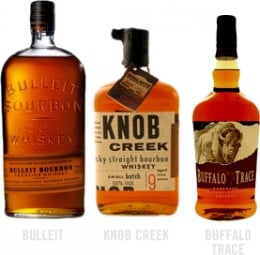
Bourbon
This beverage was invented by Elijah Craig from Bourbon County, Kentucky around 1789. By law, it must be made in the US, be 51% from corn (most are 70-80%) and the other ingredients are rye and malted barley. The corn being the main ingredient makes it sweeter than rye whiskey. The use of rye is what gives bourbon its spicy notes.
Bourbon is often referred to as "Kentucky Bourbon". Despite the name, bourbon can legally be made anywhere in the US. In fact, despite owning 95% of production, there are several states that distill bourbon outside of Kentucky, including Tennessee, Pennsylvania, Colorado, and even New York.
Bourbon production is subject to series of stringent rules and regulations that dictate distilled proofing, age proofing, water source, wood, ageing, grain mixtures and the integrity of no added colour or flavor.
That last is important, and as a result of the rule, flavor must be taken from the ageing process. Charred new American oak is used to age these whiskeys, giving them smoky aromas and extra notes of caramel and spice.
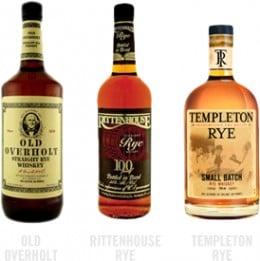
Rye Whiskey
American rye can be made anywhere in the United States. American rye has to be made from at least 51% rye mash mixture, not higher than 160 proof and aged in new American oak.
George Washington produced rye at Mount Vernon, and it was the most common whiskey of the north-eastern states. It all but died out after prohibition, but like many rather old-fashioned drinks (and the Old Fashioned itself) it has seen a revival in recent years.
The use of rye gives the whiskey an apparent difference in flavor in comparison with bourbon, and is considerably spicier, and are smoother with a strong bitter character.
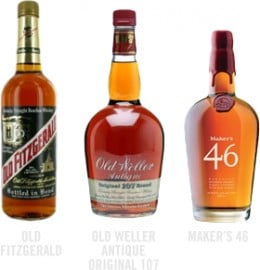
Wheated Bourbon
In a wheated bourbon, rye is replaced by wheat. It's as simple as that. The result is a somewhat sweeter whiskey. Maker’s Mark is the most common and well-known whiskey of this type.
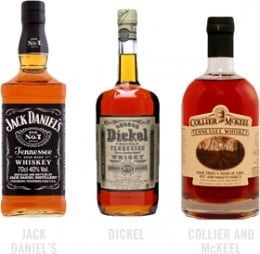
Tennessee Whiskey
I may as well have titled this section as “Jack.” The ubiquitous black label, the signature straight shot, the rock and roll icon of all whiskeys – Jack Daniel’s has made an international name for Tennessee whiskey. In fact, it's the most popular brand of whiskey in the world.
Aside from Jack Daniel's, there's little else that can be counted as Tennessee whiskey. One example is George Dickel’s Tennessee whisky (they drop the “e” for some reason). It is however, notoriously hard to come by.
Tennessee whiskey is made exactly like bourbon, but with one extra key step known as the “Lincoln County Process”. Tennessee had a state instituted prohibition that outlasted the national prohibition, meaning only a small number of distilleries have survived.
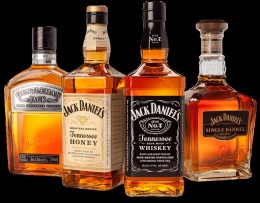
Many people think that Jack Daniel’s – rather Tennessee whiskeys – are in fact bourbons, or conversely, that they are not bourbons because they are distilled outside of Kentucky.
Tennessee whiskey is not bourbon. However, the reason for it not being whiskey instead is less to do with where it’s not produced but how it’s made.
As previously mentioned, Tennessee whiskey is made just like bourbon, but with the addition of the “Lincoln County Process”. Before being put in charred oak barrels to age, it's poured over sugar maple charcoal. The result is mellower, gently sweeter, and smoky. By definition, bourbon is prohibited from using any kind of filtering to add flavor, thus why Jack Daniel's is whiskey rather than bourbon.
What next?
I hope you enjoyed that whistle-stop tour of American whiskey. If you did, you may be interested in the other articles that make up this guide:
- Part 1 - Irish Whiskey and its Origins
- Part 3 - Canadian and Japanese Whisky
- Part 4 - Scottish Whisky (Scotch)
As always, thank you for reading, and please feel free to leave a comment below.








